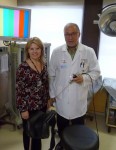Shauna Leeson and Dr. Richard Boroditsky. (photo by Rebeca Kuropatwa)
According to Dr. Richard Boroditsky, medical director of Winnipeg’s Mature Women’s Centre, hysterectomies are procedures that happen too frequently and are often unnecessary. Boroditsky has spearheaded a new program to give women effective alternatives to hysterectomies.
The program, called HAlt (Hysterectomies Alternatives), is managed by Kerry Antonio, and previously by Shauna Leeson, both nurse clinicians who have been working at Mature Women’s Centre since 2004. In 2006, the centre moved to Victoria Hospital.
There are currently three physicians working with HAlt – Boroditsky, his son Dr. Michael Boroditsky and Dr. Deb Evaniuk.
Patients are often referred by their family physician. The majority are in the age range of 30-55, with heavy or painful periods, and all want to improve their quality of life. Women in the post-menopausal stage are also seen at HAlt. “The majority of the patients we see here have benign ‘disease,’” Leeson told the Jewish Independent.
“Too many women are being told they have only two choices: do nothing or get their uterus taken out. We see about 20 new patients per month. We’re here to give them other options to hysterectomy and we do this because we understand the consequences of having one.”
Leeson added, “If a women in her 40s or 50s is going to have a hysterectomy, she may need to take six to eight weeks or up to three or four months off work and her regular duties, where often her problem can be treated with medication or other alternatives.”
According to Boroditsky, “Manitoba probably has one of the highest hysterectomy rates in Canada, with some 2,300 hysterectomies per year in the province.
“Traditionally, the main reason for doing about 70 percent of hysterectomies has been abnormal bleeding. And, before we had some of the newer alternative hysterectomy technologies, there wasn’t much we could offer women.”
The doctor said one of the most common issues they see is a condition called uterine fibroid (benign lumps in the uterus). “We used to believe this meant women in this situation automatically needed a hysterectomy,” he explained.
“Hysterectomy is a major operation with major complications – including risks of general or spinal anesthesia, hemorrhaging, infection and damage of organs around the uterus,” like the bowel, bladder, ureter, etc. “With these serious, major complications that can occur, we shouldn’t be taking hysterectomies lightly,” he said. “We can’t look at hysterectomy as the ultimate treatment for uterine bleeding – it shouldn’t be the first choice. It should only enter into the picture after you’ve tried or considered all other available alternatives.”
In the past, Boroditsky said that he has done at least as many, if not more, hysterectomies than other physicians, but that has changed in recent years. “I’ve gone the other way. I now believe hysterectomies should be only a last resort.”
He added, “One particular study was done about eight or nine years ago in the States, where they looked at several thousand hysterectomies and found that some 70 percent of them could have been treated or managed with other alternatives.”
In Europe, alternatives to hysterectomies are more accepted due to the attitudes of both the doctors and the patients, said Boroditsky. “In Canada, many women, and even doctors, don’t know about or will not consider alternative options.
“There is a lot more cost involved in having a hysterectomy than there is for the alternatives: cost to the system, physical and psychological cost to the woman and to her family. The only way we can make an accurate diagnosis of abnormal uterine bleeding is to look inside the uterus (hysteroscopy). Once you make the diagnosis, there are many alternatives for treatment, depending on each individual case, whether that’s with pills, a device or otherwise.”
The HAlt website offers basic information and some of the benefits of the alternatives to hysterectomy. “Due to the risks associated with major surgery, as well as the negative effects hysterectomy can have on a woman’s self-esteem, their sexual experience and perceived desirability, women are seeking alternative treatments to fibroids and uterine bleeding. The HAlt program aims to provide women with information and awareness of options, including the use of medical alternatives to control bleeding, minimally invasive surgery, and other less invasive techniques.”
Some of the medical alternatives available today include the use of an intrauterine progestin device, which prevents pregnancy but significantly reduces menstrual flow; pituitary gonadotropin inhibitors, which lock estrogen receptors in the uterus to suppress hormone levels and thin the lining of the uterus; oral contraceptives to minimize and regulate menstrual bleeding; gonadotropin-releasing hormone, which produces a menopause-like state, indirectly lowering estrogen levels and shrinking fibroids; and selective progesterone receptor modulators, which act directly on the fibroids and the lining of the uterus, leading to fibroid shrinkage and decreased bleeding.
As noted on the website, patients can consider adding procedures in consultation with their doctors, such as endometrial ablation, hysteroscopic resection of polyps and fibroids, as well as uterine fibroid embolization.
Rebeca Kuropatwa is a Winnipeg freelance writer.

